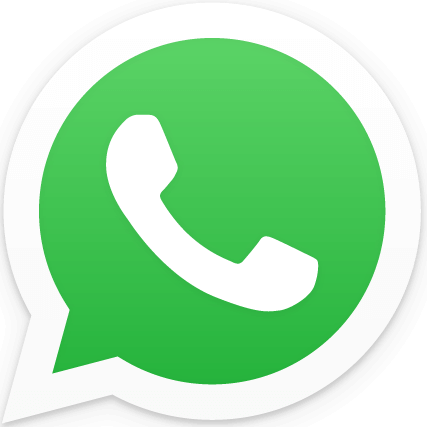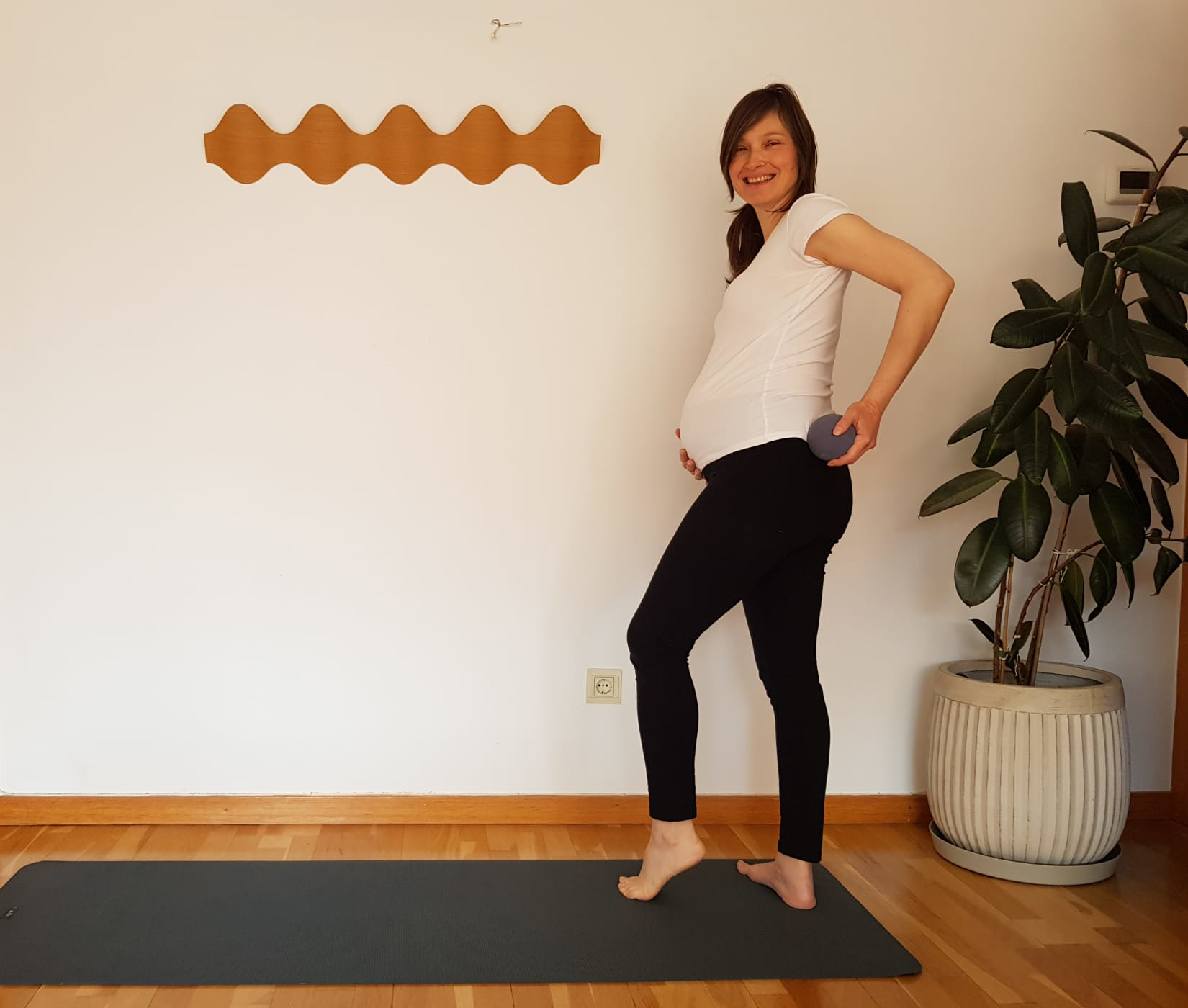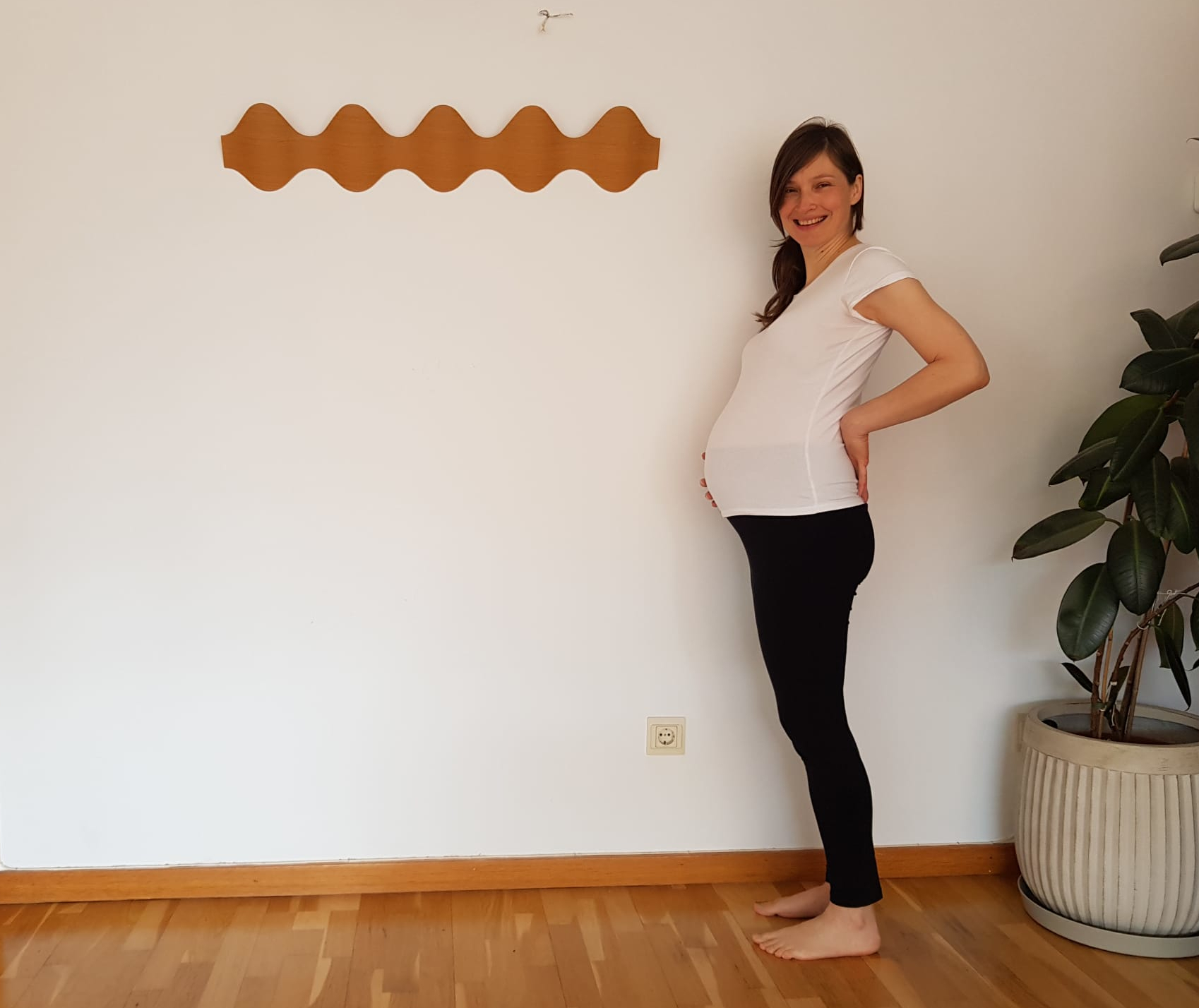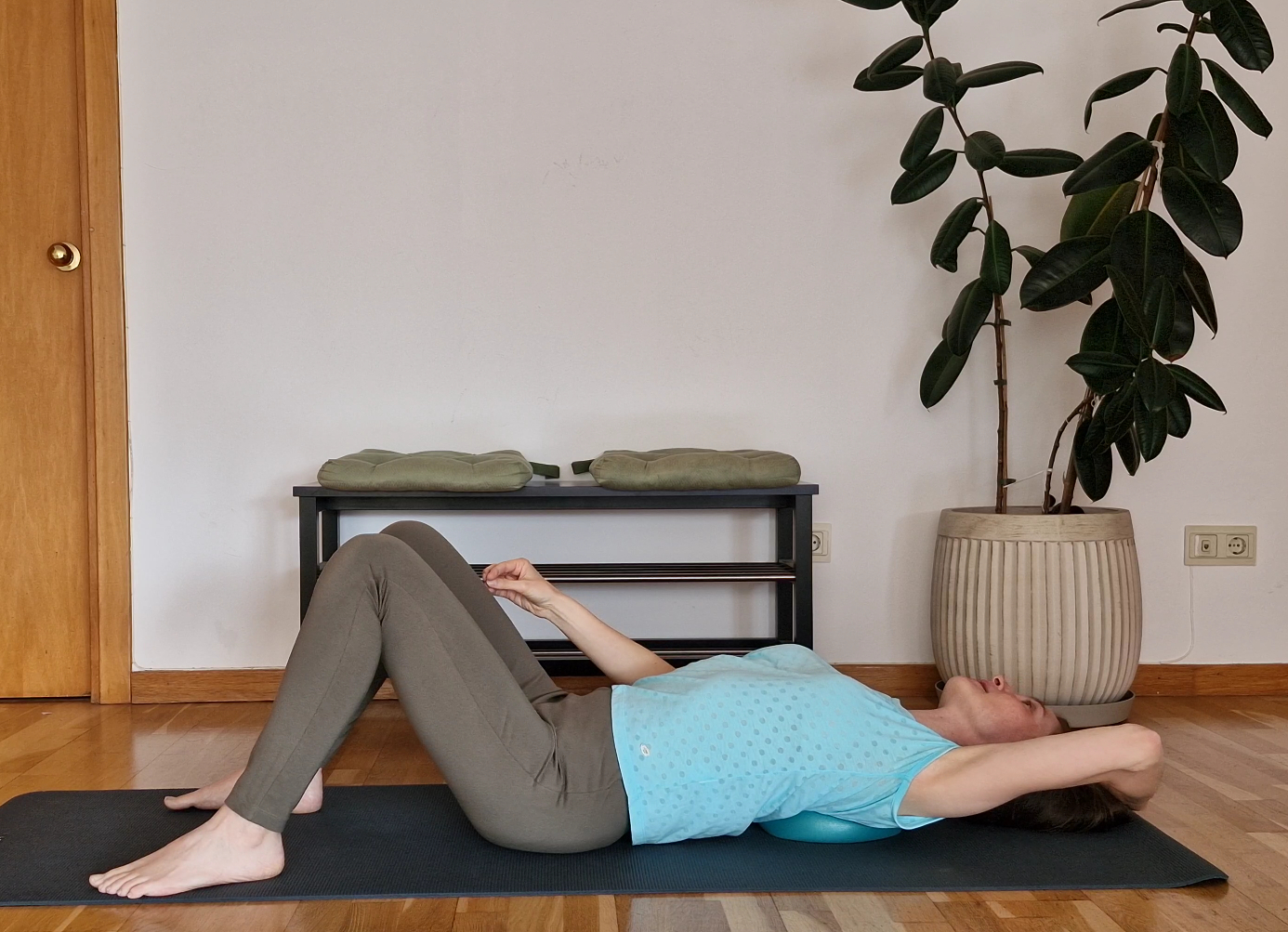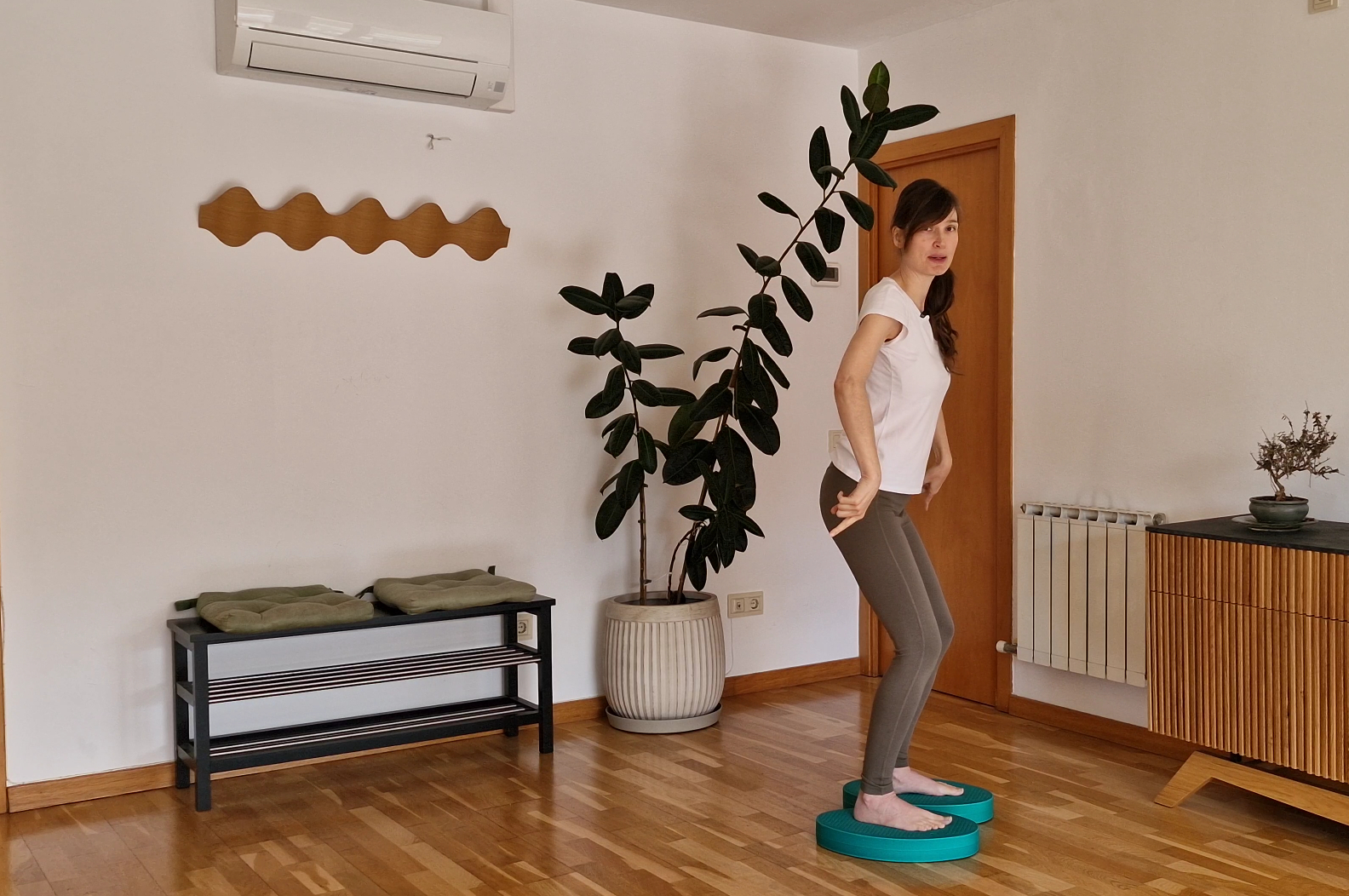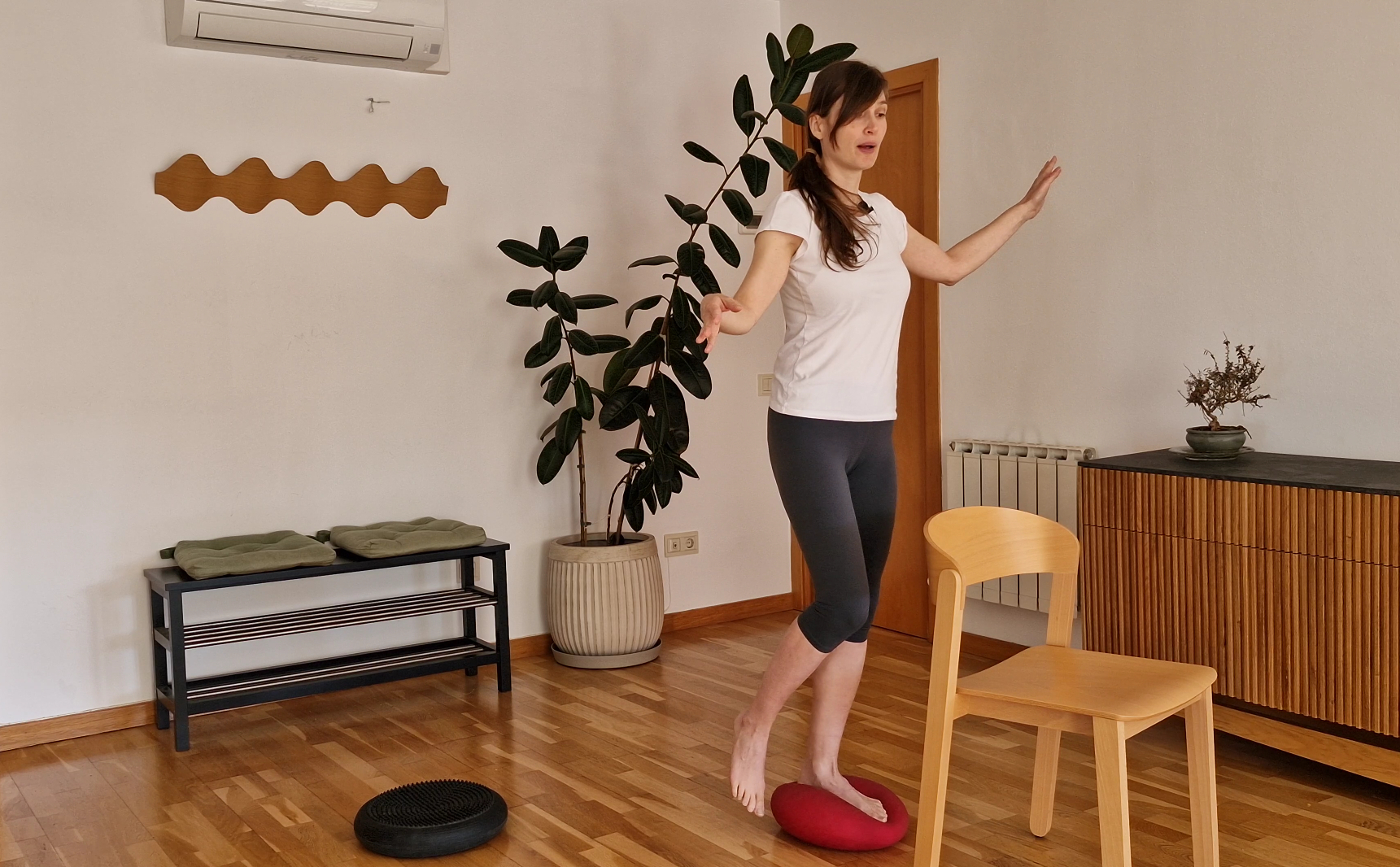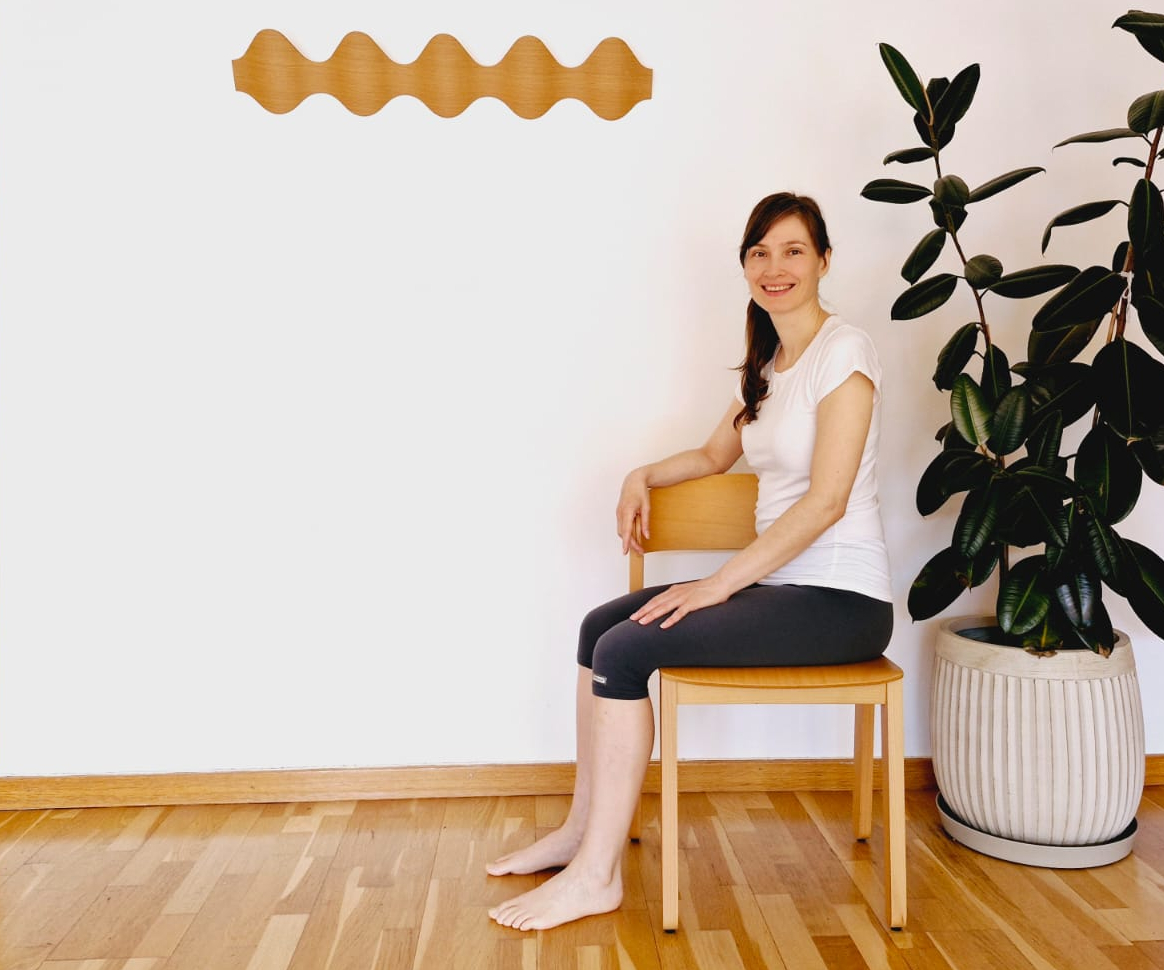Back Pain During Pregnancy (Part 4) - Sacroiliac pain (by Izabella Jónás) (3-May-2025)
In this video, we'll practice self-massage to relieve sacroiliac pain during pregnancy.
Back Pain During Pregnancy (part 3) - Releasing tense muscles (by Izabella Jónás) (26-April-2025)
In this video, we'll practice exercises to release tense muscles and prevent back pain during pregnancy.
Back Pain During Pregnancy (Part 2) - Softening back muscles (by Izabella Jónás) (19-April-2025)
In this video, we'll practice exercises to soften muscles and the fascial system to prevent back pain during pregnancy.
Back Pain During Pregnancy (part 1) - Posture Awareness (by Izabella Jónás) (14-April-2025)
In this video, I explain how awareness of our posture helps to prevent back pain during pregnancy
How to reduce swelling of ankles during pregnancy? (by Izabella Jónás) (25-March-2025)
In this video, we practice some self-massage in order to reduce swelling of ankles during pregnancy.
Exercices to improve our health (by Izabella Jónás) (23-November-2024)
In this video, we talk about exercises that help to improve our health and we take a look at their main caracteristics.
How to improve your balance (part 4) (by Izabella Jónás) (26-October-2024)
In this video, we will improve our balance through finding more fluid movement and fluidity in our bodies.
How to improve your balance (part 3) (by Izabella Jónás) (19-October-2024)
In this video, we will improve our balance through releasing muscle tension.
How to improve your balance (part 2) (by Izabella Jónás) (12-October-2024)
In this video, we will improve our balance through practicing some exercises with a stability trainer.
How to improve your balance (by Izabella Jónás) (5-October-2024)
Do you know that when you lose mobility in your ankles, you start losing your balance? In this video, we'll improve our ankle mobility and in the same time our balance.
How to rejuvenate your body (by Izabella Jónás) (15-September-2024)
In this video, we take a look at how we can rejuvenate our bodies and find our physical health.
Yoga exercises for the beach (by Izabella Jónás) (29-July-2024)
In this video, we take a look at three yoga exercises tha tyou can practice on the beach.
Say Goodbye to Foot Pain! Easy Exercises with a Ball (by Izabella Jónás) (13-July-2024)
In this video, we take a look at some feet exercises with a ball to release tension from feet and toes in order to avoid pain.
How to calm anxiety (by Izabella Jónás) (29-June-2024)
In this video, we take a look at how to calm anxiety quickly in a few minutes.
Exercises for office work (by Izabella Jónás) (16-June-2024)
In this video, we take a look at some exercises that help you to be more present with your work and it will also prevent pain.
Three factors to improve sitting positions (by Izabella Jónás) (1-June-2024)
In this video, we see three factors to improve the way you sit and thus avoid pain that can develop.
A class to lengthen the spine (by Izabella Jónás) (12-May-2024)
In this video we see a part of a class to lengthening the spine. We will see how my student grows 1 cm in height at the end of the class.
A sequence to strengthen paravertebral muscles (by Izabella Jónás) (6-April-2024)
In this video, we take a look at a sequence of exercises from the easiest to the most difficult to strengthen our paravertebral muscles.
Three signs of stress in your thorax (by Izabella Jónás) (23-March-2024)
In this video, we take a look at how stress accumulates in our thorax. We identify three signs in our bodies and we practice two exercises to relieve this stress on our thoracic spine.
Three signs of stress in your pelvis (by Izabella Jónás) (16-March-2024)
In this video we take a look at how stress accumulates in our pelvis. We identify three signs in our bodies and we practice three exercises to relieve this stress on the pelvis.
Rehabilitation of the back Step by Step (part 4) (by Izabella Jónás) (24-February-2024)
Have you had an injury or a muscle spasm in your back? In this series of videos we take a look at step by step how to rehabilitate our back. In this fourth part, for the first time, we start to train the affected area.
Rehabilitation of the back Step by Step (part 3) (by Izabella Jónás) (10-February-2024)
Have you had an injury or a muscle spasm in your back? In this series of videos we take a look at step by step how to rehabilitate our back. In this third part, we already start to train the whole body except the injured area.
Recovery of the back step by step (part 2) (by Izabella Jónás) (27-January-2024)
Have you had an injury or a muscle spasm in your back? In this series of videos we take a look at step by step how to rehabilitate our back. In this second part, we lengthen our spine and loosen up the muscles of the legs to help our recovery.
Recovery of the back step by step (part 1) (by Izabella Jónás) (13-January-2024)
Have you had an injury or a muscle contracture in your back? In this series of videos, we take a look at step by step how to rehabilitate our back. In this first part, we practice rest, relaxation and listening to body so that our bodies can have its strength to recover.
How to detect stress in the body? (by Izabella Jónás) (16-December-2023)
In this video, we learn to observe where stress accumulates in our bodies.
Exercices for muscle cramps (by Izabella Jónás) (18-November-2023)
In this video, we take a look at some exercices that help to recover from muscle cramps.
Why do we have muscle cramps? (by Izabella Jónás) (4-November-2023)
In this video, we take a look at why muscle cramps exist and how they are related to our body posture.
How to improve breathing? (by Izabella Jónás) (21-October-2023)
In this video, we explore how posture is linked to breathing. When we improve our posture, lengthen our spine and loosen up tension, we naturally improve our breathing.
Exercises to strengthen our shoulders (part 3) (by Izabella Jónás) (10-October-2023)
In this video, we practice exercises for the pectoralis muscles to strengthen our shoulders. So we can relieve discomfort, pain and avoid injuries.
Exercises to strengthen our shoulders (part 2) (by Izabella Jónás) (30-September-2023)
In this video, we practice exercises to strengthen our shoulders to relieve discomfort, pain and avoid injury.
Exercises to strengthen our shoulders (part 1) (by Izabella Jónás) (16-September-2023)
In this video, we practice exercises to strengthen our shoulders to relieve discomfort, pain and avoid injury.
Exercises to relieve pain from wearing high heels (by Izabella Jónás) (2-September-2023)
In this video, we practice some exercises to relieve discomfort and pain from wearing heels.
How our posture changes when wearing heels? (by Izabella Jónás) (22-July-2023)
In this video, we take a look at how our posture changes by wearing high-heeled shoes and the consequences it can have on our bodies.
Relationship between hip tension and posture (by Izabella Jónás) (1-July-2023)
In this video, we take a look at the relationship between hip tension and posture. We look at how you can detect if you have tension in your hips when you're standing and we look at some exercises to release tension in the hips and improve our posture.
Relationships between low back pain and hip tension (by Izabella Jónás) (17-June-2023)
In this video, we take a look at the relationship between low back pain and hip tension. We look at how you can detect if you have tension in the hips and we practice some exercises to loosen up this tension.
Therapeutic exercises for lower back pain with foam roller (by Izabella Jónás) (3-June-2023)
In this video, we take a look at five exercises with a foam roller to relieve lower back pain.
Therapeutic exercises for lower back pain (by Izabella Jónás) (20-May-2023)
In this video, we take a look at some exercises with an inflated ball to relieve lower back pain.
How to strengthen your glutes more efficiently (by Izabella Jónás) (6-May-2023)
In this video, we take a look at how to strengthen your glutes more efficiently and we practice some exercises.
How to avoid a rounded back with foam roller (by Izabella Jónás) (23-April-2023)
In this video we take a look at three exercises with a foam roller in order to avoid the rounded back.
A new way to avoid a rounded back (by Izabella Jónás) (8-April-2023)
In this video, I explain a new way to avoid a rounded back and we practice some exercises.
Three exercises for a rounded back (by Izabella Jónás) (25-March-2023)
In this video, we take a look at three exercises to avoid and recover from a rounded back.
Exercises to recover and avoid bunions (by Izabella Jónás) (11-March-2023)
In this video, we take look at some exercises to prevent the development of bunions and if you already have them, how to recover from them.
Bunions: how they develop and how to prevent them (by Izabella Jónás) (25-February-2023)
In this video, we talk about how bunions develop and how to prevent them. Also, we will take a look at how to choose your shoes in order to prevent their development.
Two exercises to detect the origin of knee pain (by Izabella Jónás) (11-February-2023)
In this video, we look at how insufficient mobility in your hips and ankles can cause knee pain. We use two exercises to detect where it is coming from.
Exercises to calm the mind (by Izabella Jónás) (4-February-2023)
In this video we practice some exercises that help you to calm your mind, your thoughts and bring more presence into your body.
Exercises for low back pain (by Izabella Jónás) (21-January-2023)
In this video we practice some exercises that help you alleviate low back pain and thus help to loosen up tension in the lumbars.
Mindfulness and movement classes (by Izabella Jónás) (14-January-2023)
The third line of my classes is designed to learn to relax and release ansiety. Through meditation and body movements we learn to connect our minds with our bodies and find tranquility.
Classes to improve strength and posture (by Izabella Jónás) (17-December-2022)
The second line of my classes is designed to strengthen your body, learn good ways to move and improve your posture. In the video you can see some exercises we do.
Classes to relieve tension and rest deeply (by Izabella Jónás) (10-December-2022)
These classes are designed so that you can relieve tension, connect more deeply and relax your body and mind. In this video you can see the exercises we do.
A practice for managing stress and anxiety (by Izabella Jónás) (26-November-2022)
In this video, we take a look at a practice that helps you to train your mind in order to be more present, manage stress, anxiety and to calm down.
Tone your triceps in a more therapeutic way! (by Izabella Jónás) (12-November-2022)
In this video we look at how to tone your triceps in a more therapeutic way and we practice three exercises with an elastic band.
Three exercises to tone your triceps without injuring your shoulder (by Izabella Jónás) (5-November-2022)
In this video we look at three exercises to tone your triceps with free weights while we take care not to injure the shoulder.
New classes of whole body strengthening (by Izabella Jónás) (23-October-2022)
In this promotional video I talk about my new whole body strengthening classes.
Moving with less effort from deep muscles (by Izabella Jónás) (15-October-2022)
In this video we contrast habitual, automatic movements with movements that are conscious and come from the depth of the body, from bones. I explain their relationships with physical effort while moving and I show you in 3 exercises so you can see their differences.
Second principle to strengthen deep muscles: moving from bones (by Izabella Jónás) (8-October-2022)
In this video we talk about why to move from bones in order to strengthen deep muscles. We also practice 3 exercises to see how it is like to move from bones.
First principle to strengthen deep muscles: to be present (by Izabella Jónás) (1-October-2022)
In this video, we talk about why to get present in order to strengthen deep muscles. We also look at the practice to connect with our bodies so we can become more present.
2 principles to strengthen deep muscles (by Izabella Jónás) (24-September-2022)
In this video, we look at the 2 essential principles to strengthen the deep musculature. First we need to be present to the body and second to learn to move from the deepest tissues, the bones. Come and listen to the video.
How to lengthen your spine? (by Izabella Jónás) (10-September-2022)
In this video we look at how to lengthen the spine: creating spaces between the vertebraes and loosening its musculature. We also look at some movements to experience a taller spine.
Three aspects of a bodywork in order not to interfere with our natural posture (by Izabella Jónás) (13-August-2022)
In this video we look at three aspects of bodywork that help us go out off the way to interfere with the natural function of our bodies. We give examples of some exercises.
How we interfere with our posture (by Izabella Jónás) (30-July-2022)
In this video we will see how unconsciously we create tensions and thus we interfere with the natural posture of our bodies. We also take a look at some examples so that you can see it better.
How to feel lighter through a better posture (by Izabella Jónás) (16-July-2022)
In this video we talk about Ground Reaction Force - how the ground pushes any weight upward. If we take advantage of this force, it helps us to have a better posture and feel our bodies lighter.
Keys to good posture (by Izabella Jónás) (9-July-2022)
We take a look at two myths about posture. As we have been told: Straighten Up!, we have been led to believe that good posture has to be tense and static. While good posture is effortless and dynamic. I explain it in the video.
Exercises to improve flexibility #4-reactivate dormant muscles (by Izabella Jónás) (18-June-2022)
When we can deactivate and release the habitually tense muscles, it is when the dormant muscles begin to awake. Then we really start to regain our flexibility. In this video we take a look at the steps we need in order to achieve it.
Exercises to improve flexibility #3-through allowing movement (by Izabella Jónás) (04-June-2022)
When we start allowing movement in areas of the body that have rigidity, we begin to release tension and thus improve our flexibility. In this video we look at an exercise that you can also practice.
Exercises to improve flexibility #2-through rest (by Izabella Jónás) (21-May-2022)
Did you know that rest helps you release tension and thus improve your flexibility? In this video we look at some exercises that you can practice.
Exercises to improve flexibility. #1-How to release chronic muscle contrature (by Izabella Jónás) (07-May-2022)
Did you know that if you release muscle chronic muscle contracture, you improve your flexibility? In this video we look at some exercises with a foam roller that help you to achieve it.
How to regain our flexibility? (by Izabella Jónás) (23-Apr-2022)
Did you know that our body reacts and tenses up in certain situations? These tensions accumulate over the years and that is why we lose our flexibility and feel rigidity. While if we have a regular practice that helps to loosen up tension in the body, then we can regain our flexibility.
Why become aware of your body? (by Izabella Jónás) (02-Apr-2022)
Do you know that if you become aware of your body, this brings you satisfaction and happiness? When you are more in contact with your body, you will see more clearly how you feel and what your needs are so then you will be able to look for solutions. While if you are only in your mental space you will not be in touch how you feel so you will not be able to find solutions for your problems. In this video I explain it with some examples so that you can understand it well.
How to train your mind to reduce stress? (by Izabella Jónás) (19-Mar-2022)
Do you know how to train your mind so your thoughts do not stress you out? In this video I explain a practice that helps you notice faster that you lost in thoughts and you will learn to anchor yourself to your breath to find tranquility and calmness.
How do compensations cause injuries and chronic pain? (by Izabella Jónás) (19-Feb-2022)
Do you know that postural compensations are caused by less mobility and accumulated tensions? That is why when we move, the body begins to make compensatory movements and that is what in the long term causes injuries and chronic pain. In this video, I explain it with several examples.
What are postural compensations and how they affect your body? (by Izabella Jónás) (29-Jan-2022)
Do you know that pain and poor posture cause postural compensations? When there is one compensation in your body, this lead to a series of other compensations in the globality of your body. In this video, I explain it to you with an example.
My Classes: Undoing tensions to avoid injuries and chronic pain (by Izabella Jónás) (19-Dic-2021)
Do you know that there are tensions and compensations in the body that if we do not take care of, they cause injuries and chronic pain? In this video, I explain how I discovered them and how I work with them in my classes.
How to choose your foam roller? (by Izabella Jónás) (20-Nov-2021)
Let's compare the Melt Method roller with most of foam rollers that are hard and developed for myofascial release, while the roller of the Melt Method is softer and is more suitable for working the fascial system of the whole body. I explain it more in the video.
How to loosen up tension at the base of the head? An exercise with a foam roller (by Izabella Jónás) (13-Nov-2021)
Did you know that tension in the jaw, shoulders and back causes tension at the base of the head? In this video we do an exercise with a foam roller that helps to loosen up tension at the base of the head and thus can relieve discomfort and stiffness in the body, improving our posture.
Stiffness in the thorax? An exercise to improve the mobility of thoracic spine. (by Izabella Jónás) (30-Oct-2021)
Did you know that it is very common to have stiffness in the thorax and this can cause pain or poor posture? In this video we practice an exercise to loosen up stiffness in thoracic spine with the help of a foam roller.
How to relieve low back pain? An exercise to mobilize sacroiliac joint (by Izabella Jónás) (16-Oct-2021)
Did you know that low back pain often comes from a blockage at the sacroiliac joint? In this video, we take a look at an exercise that helps you to loosen up stiffness and relieve pain with the help of a foam roller.
Foam roller... what it is for and how it affects your body (by Izabella Jónás) (5-Oct-2021)
In this video I show you the foam roller and I will explain what it is for and when you use it how it affects your body.
My technique to release physical tensions (by Izabella Jónás) (18-Sept-2021)
In this video I explain how I came to use soft inflatable balls to release physical tensions.
An exercise to open up the thoracic spine (by Izabella Jónás) (01-Sept-2021)
In this video we practice an exercise with a small ball that helps to open up thorax and thoracic spine.
How to strenghten paravertebral muscles? (by Izabella Jónás) (25-August-2021)
In this video we practice an exercise that helps to strengthen paravertebral muscles in lower back. We will use balls that not only strengthen but also release tension from pelvic and lumbar area.
What is the psoas muscle and how to activate it? (by Izabella Jónás) (12-August-2021)
In this video I explain what the psoas muscle is, what you need to know about it and we take a look at a practice that helps to activate it.
How to use your abs efficiently? (by Izabella Jónás) (31-July-2021)
In this video I explain how to use your abs efficiently to avoid injuries. You can also try a small practice.
How to strengthen your deep muscles? (by Izabella Jónás) (24-July-2021)
In this video I explain how to strengthen your deep muscles. We look at the best position to do it and some tools that can help you to achieve it.
What are the deep muscles? What is their function? (by Izabella Jónás) (03-July-2021)
In this video I explain what the deep muscles are and what their function is. I also show you some examples of them.
HAY UNA REALIDAD SUBYACENTE - Mis estudios en la craneosacral biodinámica (by Izabella Jónás) (19-June-2021)
Bajo de la realidad que vemos y tocamos, hay una realidad subyacente invisible que ordena todo lo que vemos. Tanto en el universo como en el cuerpo humano existe esta realidad más sutil que organiza nuestra realidad y nuestro cuerpo.
Freedom of movement - What is it and why it is interesting for you? (by Izabella Jónás) (22-May-2021)
In this video I explain how you can transform physical tension into freedom of movement.
Movement practices help us to become more conscious (from a New York Times article) (by Izabella Jónás) (09-May-2021)
Movement practices help us to be more aware according to a journalist of New York Times. There are some principles that help us to connect with our tranquility and inner freedom. In this videoblog I explain you about the article and these principles.
Four steps in the prevention of injury (by Izabella Jónás) (24-Apr-2021)
Do you know the 4 steps that help you to prevent injuries? I explain these 4 steps in this videoblog...
Why do we get muscle tension and we get injured? (by Izabella Jónás) (10-Apr-2021)
Do you know why we get muscle tension and finally injured? I explain the reason in this videoblog...
Fascia and mobility: why do we feel stiff? (by Izabella Jónás) (27-Mar-2021)
Do you know that fascia influences our mobility. I explain the reason in this videoblog...
What is fascia? (by Izabella Jónás) (14-Mar-2021)
Do you know what fascia or connective tissue is and how it influences our posture? I explain it to you in this videoblog ...
How to sit if you have a hernial disc (by Izabella Jónás) (20-Feb-2021)
I explain two important things that you have to take care of when you are sitting and have a herniated disc.
Centralization vs peripheralization if you have a herniated disc (by Izabella Jónás) (14-Feb-2021)
What does it mean if your pain centralizes or peripherals? I explain in this video.
Extension of the spine if you have a herniated disc (by Izabella Jónás) (24-Jan-2021)
Do you have a herniated disc? In this video post I explain a classic exercise that will help you relieve your chronic pain ...
How to relieve pain if you have a hernial disc (by Izabella Jónás) (24-Dec-2020)
Do you have a herniated disc? In this video post I explain an exercise to safely relieve pain ...
Herniated disc and resting position (by Izabella Jónás) (14-Nov-2020)
Do you have a herniated disc? You would like to learn how to relax your back before doing any exercise. In this video post I explain how to do it ...
How to stand up and lie down safely if you have a herniated disc (by Izabella Jónás) (23-Oct-2020)
Do you have a herniated disc and are you having difficulty getting up and down? In this video post I explain how to do it safely ...
What is there to know about a herniated disc? (by Izabella Jónás) (03-Oct-2020)
Do you know what causes a herniated disc and how to prevent it? In this video post I explain its development at the anatomical level ...
How to lift a weight off the ground without injuring your back (by Izabella Jónás) (14-Aug-2020)
Has it ever happened to you that after lifting weights your back hurt? In this video post I explain how to do it correctly ...
Mi experiencia de practicar yoga desde la escucha (by Izabella Jónás) (21-Setiembre-2019)
La práctica de yoga, pilates o cualquier otro ejercicio es, en principio, algo muy bueno. Sin embargo, a veces pasa que forzamos demasiado en una postura o en un ejercicio provocando contracturas o incluso alguna lesión.
Qué es el Yoga & Movement Therapy? (by Izabella Jónás) (04-Agosto-2019)
Vivimos en un mundo con mucha distracción, prisa y estrés. Por eso hay una necesidad de relajarse, centrarse y conectar con uno mismo para que podamos conectar mejor con los demás y vivir nuestra vida con sentido. Para esta necesidad nació, lo que yo llamo, el Yoga & Movement Therapy.
Tres claves para evitar lesiones (inspirado por J.H.Pilates) (29-Junio-2019)
Joseph H. Pilates es famoso por ser el creador del llamado Método Pilates. Poca gente sabe que en realidad su programa de ejercicios lo llamó Contrology. ¿Pero qué quería transmitir con el nombre de Contrology en lugar de poner directamente Método Pilates? En su libro nos da una pista al respecto: “...aprendes a controlar el cuerpo con la mente y no te dejas dominar por el mecanismo reflejo de los músculos”. ¿Pero qué significa exactamente esta frase? Para entenderlo bien, vamos a desentrañar su significado.
Los beneficios del yoga suave (07-Mayo-2019)
Kristine Weber, la fundadora de Subtle Yoga, explica las diferencias entre un yoga suave y un yoga de fitness. Tienen beneficios y objetivos diferentes. Mientras que un yoga de fitness tiene beneficios cardiovasculares, un yoga suave tiene un foque diferente, desarrolla la consciencia interna y la resiliencia del sistema nervioso.
Psoas, un músculo esencial para una buena postura (23-Marzo-2019)
El psoas es el músculo profundo que conecta la columna con las piernas. Tenemos dos psoas, uno en cada lado de la columna. Se originan en la vértebra torácica 12 (Th12) y en cada una de las vértebras lumbares (L1-5), cruzan la pelvis por delante de las articulaciones de las caderas y se insertan en el trocanter menor del fémur (la parte interna de la pierna).
Tres ejercicios eficientes para flexibilizar la columna (02-Febrero-2019)
La mejor manera a flexibilizar la columna, es cuando los músculos y los tejidos de la espalda están lo más relajados posible. Así la posición más adecuada sería tumbada en el suelo con las piernas dobladas, y con los pies en el suelo. Esta posición la llamamos la Posición de Descanso.
Una columna flexible y sus articulaciones (27-Julio-2018)
Hay un dicho que dice somos tan jóvenes cómo lo es nuestra columna. Así que tener una columna flexible nos mantiene jóvenes, nos hace sentir mejor y previene dolores musculares. Para mejorar la flexibilidad de nuestra columna a través del movimiento, sería útil saber cómo se construye la columna.
El estrés y el sistema nervioso (06-May-2018)
Hemos aprendido en la escuela que la sistema nervioso autónomo se divide en el sistema simpático y el sistema parasimpático. Para qué sirven? El sistema simpático nos prepara para correr y luchar, en otras palabras prepara el cuerpo para sobrevivir y genera el miedo. Por otro lado, el sistema parasimpático, ayuda a curarse, descansar y recuperarse. Éste último, controla los funciones de los sistemas digestivo, cardíaco y respiratorio a través del nervio vago.
Rasgos de la personalidad con problemas digestivos (12-Mar-2018)
¿Los problemas digestivos pueden tener un origen psicológico?
Angela Privin, una coach de nutrición, habla sobre los rasgos de personalidad de las personas con el Colon Irritable o Síndrome del Intestino Irritable (SII). Ella ha observado estos rasgos en si misma y en sus clientes.
Sobrecrecimiento Bacteriano del Intestino Delgado (18-Feb-2018)
Tienes malestar digestivo? Tu barriga se hincha por las tardes? Tienes diarrea o estreñimientos frecuentemente?
El sobrecrecimiento bacteriano del intestino delgado (SBID o SIBO en inglés) puede producir estos síntomas mencionados. También es el posible origen del síndrome del intestino irritable o el colon irritable.
Osteoporosis – la “Paradoja del Calcio” (21-Ene-2018)
Para evitar y curar el osteoporosis mucha gente toma suplementos de calcio y vitamina D pensando que ayudan a sus huesos. La verdad es que sin la vitamina K2 este régimen puede llegar a ser peligroso.
La vitamina D sirve para absorber el calcio, mientras que la vitamina K2 dirige el calcio absorbido a los huesos. Si la persona no toma vitamina K2, el calcio se deposita en los arterias y en los órganos blandos, causando arteriosclerosis y piedras en los riñones por ejemplo. El resultado es una combinación de arteriosclerosis y osteoporosis, lo que se conoce como la Paradoja del Calcio (“Calcium Paradox”).
Vitamina K2: La vitamina más olvidada (27-Dic-2017)
¿Quieres tener dientes fuertes y prevenir osteoporosis y enfermedades cardiovasculares?
Los investigadores recientemente han descubierto que la mayoría de la población tiene deficiencia de vitamina K2. La vitamina K2 previene que el calcio se deposite en las arterias y en los tejidos blandos. Su mayor función es la de llevar el calcio a los huesos y a los dientes.
Maloclusión dental (17-Dic-2017)
Hace años teniendo la experiencia de trabajar con un quiropráctico, aprendí que nuestra estructura corporal influye nuestra calidad de vida. Ahora, de nuevo, me ha llegado este mismo mensaje a través de una entrevista que he escuchado.
Así fue en breve: el cuerpo de un niño está en desarrollo. Su cara, su maxilar y su mandíbula necesitan ensancharse y crecer hacia delante tanto cómo la vía aérea que necesita desarrollarse para llegar a su tamaño adecuado. Sin embargo, puede llegar un momento en la vida del niño cuando su maxilar superior sobresale y sus dientes superiores frontales se proyectan hacia delante. Esto se conoce como maloclusión dental.
Cuando la vía aérea es pequeña (14-Dic-2017)
La respiración es la vida. No podemos existir sin ella. Existen casos cuando la vía aérea es más pequeña que el normal, oxigenando menos los pulmones y todo el cuerpo.
Cuando la vía aérea es pequeña, hay diferentes síntomas que se manifiestan. Los más evidentes son: roncar durante del sueño, respirar por la boca y un paladar estrecho. Es decir estas personas con una vía aérea tienen una malfunción que repercute todo el cuerpo.












